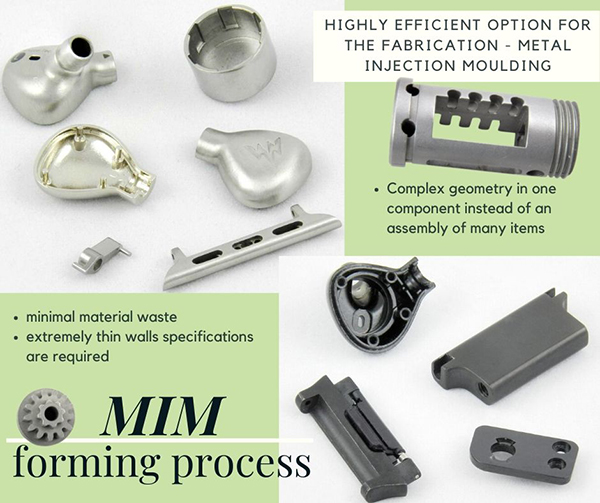METAL INJECTION MOULDING SOLUTIONS

METAL INJECTION MOULDING SOLUTIONS
Metal Injection Moulding, widely known as MIM technology, is a metalworking manufacturing technology whereby feedstock, a combination of finely-powdered metal and a binder material, is moulded through injection and solidified to form a metal component. The MIM technology is one of the environmentally friendly technologies, especially when producing small components. This technology is suitable for small metal parts because it allows producing components that require precise size tolerances. At Eurobalt, we use the MIM process to manufacture high-quality metal parts of various complex shapes and finished surfaces at a low production cost. We are also capable of branding parts marking them with a logo upon customer request. Eurobalt follows all manufacturing standards while using the metal injection moulding technology.
Metal injection moulding includes the use of two primary raw materials, which are metal powders and a binder. At Eurobalt, we use a thermoplastic binder. These materials are purchased from our long-time trusted suppliers with obligatory incoming raw material control. We mix the raw material at our facilities to get feedstock. The thermoplastic binder stands as an intermediate processing aid which will be removed from the products. The final properties of the moulded metal parts are determined by powder characteristics. The blended powder mixture is processed into plasticized binder by a kneader or a shear roll extruder at high temperatures.
MIM parts go through a moulding injection process which is similar to the forming of plastic parts. The variety of geometric forms that can be produced by the MIM technology is equivalent to the great variety of the forms of plastic components.
The binder removal process is used to obtain metal parts with a network of interconnected pores without breaking the component’s structure. The process of binder extraction still leaves behind some binder in the parts holding the metal powder particles together, however, the pore network allows the residual binder to evaporate quickly in the initial stage of sintering.
Sintering process results in the complete removal of the pore volume initially occupied by the binder. As a result, MIM parts experience shrinkage during sintering. Sintered MIM parts can further be processed using different metalworking processes, such as machining or heat treatment, in the same way as wrought or cast parts.
ADVANTAGES
TIME & COST-EFFICIENT
Metal injection moulding is a huge time-saver and cost-efficient metalworking process as compared to traditional manufacturing methods, such as die casting, investment casting, pressing, and sintering. In every manufacturing step, this technology reduces product development cycles and it does not require expensive multistage machining operations, which allows further deceasing the time to manufacture ready-made components. This process can eliminate several product finishing steps. In addition, the MIM technology makes it possible to produce different parts of intricate shapes with high precision at minimal costs.
COMPLEX PRODUCT DESIGN
MIM design removes restrictions on the design and technical requirements of metal parts. Besides, the MIM manufacturing process allows achieving the highest precision in the finished product, regardless of the complexity of its design. The MIM technology also allows producing components with precise tolerances. Compared to traditional metalworking technologies, MIM design is flexible and almost unlimited, giving the ultimate freedom to the product designer. In most cases, the MIM technology is chosen when metal components of complex shape with a finished part weight being less than 100g are required. Technically, larger MIM parts can also be produced (weighing up to 453g). Practically any structure or shape that can be achieved using plastic injection moulding can be also produced using metal injection moulding.
HIGH DENSITY FOR HIGHEST STRENGTH & TOLERANCES
The MIM technology ensures near full density of metal parts, as high as 99.5%. The MIM process allows producing components with the lowest surface roughness when compared to other technologies. Unlike traditional powder metallurgy that has its limitations, MIM parts can be plated and heat-treated similarly to wrought alloys. Metal components produced by means of MIM show integrity and exceptional strength, which makes them ideal for high-vacuum applications.
SURFACE TREATMENT AND BRANDING
Eurobalt provides a wide range of surface treatment solutions which are cost and energy efficient, safe for operators, and environmentally friendly. According to the requirements of our customers, we provide components with the surfaces ready to be finished using different treatment methods, such as electroplating, painting, and powder coating. The prime aim of surface treatment is to make the final product more resistant to corrosion or wear. Upon request, we can also mark metal components with a logo during the manufacturing process.